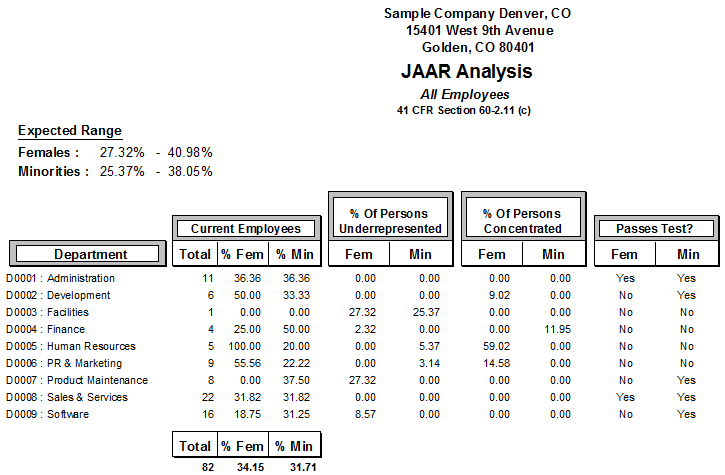Difference between revisions of "JAAR Analysis"
(Created page with "::File:JAAR Analysis.png The Job Area Acceptance Range is calculated by taking organization-wide internal availability for minorities and females and multiplying it times 20...") |
|||
| (2 intermediate revisions by the same user not shown) | |||
| Line 1: | Line 1: | ||
::[[File:JAAR Analysis.png]] | ::[[File:JAAR Analysis.png]] | ||
| − | The Job Area Acceptance Range is calculated by taking organization-wide internal availability for minorities and females and multiplying it times 20%. For example if | + | The Job Area Acceptance Range is calculated by taking organization-wide internal availability for minorities and females and multiplying it times 20%. For example if 31.71% of the entire workforce were minorities, .20 x .3171 = .06342. The Job Area Acceptance Range would be the internal availability plus or minus 6.34%. So the acceptable range for minorities would be 25.37% to 38.05%. If minority utilization in a particular department falls below this range it is considered underrepresented and further investigation should be completed to determine whether the under-representation is related to any discriminatory practices. If minority utilization in a particular department falls above this range it is considered concentrated and further investigation should be completed to determine whether the concentration is related to any discriminatory practices. The smaller the department, the more likely it is that mere size is causing the discrepancy. During a compliance review, an OFCCP investigator would be looking for broad patterns of possible discrimination indicative of an affected class. In areas identified as concentrated, OFCCP uses the following guidelines to help their own investigators identify if a pattern exists of utilizing protected group members in ways that may be discriminatory: |
* Do these jobs pay less than other job areas in the organization? | * Do these jobs pay less than other job areas in the organization? | ||
| Line 8: | Line 8: | ||
* Are working conditions in these jobs less desirable than others in the organization? | * Are working conditions in these jobs less desirable than others in the organization? | ||
| − | + | ==See Also== | |
| − | + | [[Report Options - JAAR Analysis]]<br> | |
| − | + | [[Understanding Your Reports]]<br> | |
| − | |||
| − | |||
| − | |||
| − | |||
| − | |||
| − | |||
| − | |||
© Copyright Yocom & McKee, Inc. | © Copyright Yocom & McKee, Inc. | ||
Latest revision as of 21:46, 15 November 2012
The Job Area Acceptance Range is calculated by taking organization-wide internal availability for minorities and females and multiplying it times 20%. For example if 31.71% of the entire workforce were minorities, .20 x .3171 = .06342. The Job Area Acceptance Range would be the internal availability plus or minus 6.34%. So the acceptable range for minorities would be 25.37% to 38.05%. If minority utilization in a particular department falls below this range it is considered underrepresented and further investigation should be completed to determine whether the under-representation is related to any discriminatory practices. If minority utilization in a particular department falls above this range it is considered concentrated and further investigation should be completed to determine whether the concentration is related to any discriminatory practices. The smaller the department, the more likely it is that mere size is causing the discrepancy. During a compliance review, an OFCCP investigator would be looking for broad patterns of possible discrimination indicative of an affected class. In areas identified as concentrated, OFCCP uses the following guidelines to help their own investigators identify if a pattern exists of utilizing protected group members in ways that may be discriminatory:
- Do these jobs pay less than other job areas in the organization?
- Do these jobs offer fewer fringe benefits than other job areas in the organization?
- Do these jobs have less job security than others? Do these jobs have less promotional potential than others at the same skill level?
- Are working conditions in these jobs less desirable than others in the organization?
See Also
Report Options - JAAR Analysis
Understanding Your Reports
© Copyright Yocom & McKee, Inc.
